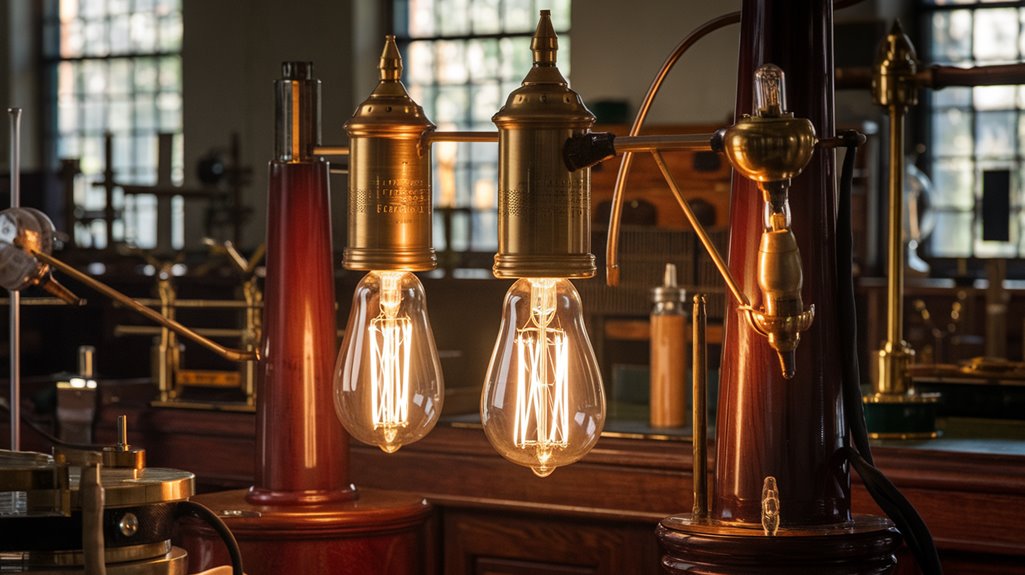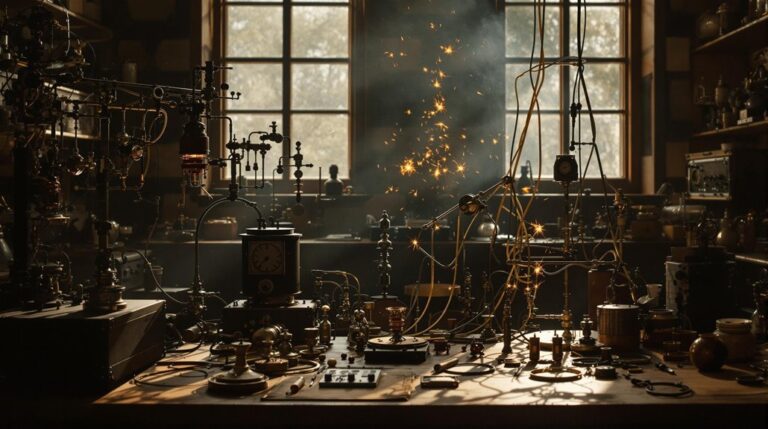Exposing the Phoebus Cartel: Bulbs That Burned Out on Purpose
You've probably never seen a light bulb that can last for decades, but they once existed. In the early 1900s, manufacturers produced bulbs with lifespans exceeding 2,500 hours – until the Phoebus Cartel changed everything. This secretive group of lighting industry giants didn't just limit innovation; they actively sabotaged their own products to boost profits. Their calculated scheme would go on to reshape consumer culture and set a dangerous precedent that still influences manufacturing today.
The Birth of a Light Bulb Conspiracy

While light bulbs were originally designed to last thousands of hours, a group of powerful manufacturers joined forces in 1925 to intentionally reduce their lifespan. Meeting in Geneva, Switzerland, industry giants like Osram, Philips, and General Electric formed the Phoebus Cartel to control the global light bulb market. This strategy of planned obsolescence became a blueprint for future industries to boost sales through intentional product degradation.
You might be surprised to learn that before the cartel's formation, light bulb innovations had pushed lifespans to 2,500 hours. The cartel slashed this to just 1,000 hours, enforcing strict penalties on companies whose bulbs lasted longer. Manufacturers faced steep financial fines if their products exceeded the mandated lifespan limit.
To maintain control, they divided market territories, shared patents, and established sales quotas. Despite their impact on consumer awareness, the cartel's existence remained largely hidden from the public until decades later, when publications finally exposed their deliberate manipulation of the market.
Inside the Dark World of Planned Obsolescence
Since manufacturers discovered the profit potential in designing products to fail, planned obsolescence has become a cornerstone of modern manufacturing.
You'll find this practice manifested in multiple ways: products engineered to break down, incompatible upgrades that force you to replace working items, and the unavailability of repair parts. The Phoebus cartel demonstrated this practice by deliberately limiting light bulb lifespans.
While companies defend this strategy by citing job creation and economic growth, the dark reality of planned obsolescence extends far beyond your wallet.
It's creating mountains of waste, depleting natural resources, and contributing to environmental pollution. The concept gained prominence when Bernard London suggested it could help prevent economic downturns during the Great Depression.
As consumer awareness grows about these deceptive practices, there's increasing pressure for ethical manufacturing alternatives.
You're not just paying more frequently for replacements; you're unknowingly participating in a system that promotes social inequality and environmental degradation through a culture of disposable consumption.
The Heavy Price of Consumer Exploitation
The staggering cost of planned obsolescence hits consumers from three devastating angles: financial drain, environmental damage, and social inequality.
Light bulbs today stem from an era when bulb lifespans plummeted under the Phoebus Cartel's manipulative schemes.
You're not just losing money; you're unknowingly participating in a system that's wreaking havoc on our planet and society.
As a conscious consumer, you'll face these harsh realities:
- You'll spend up to 50,000 euros over your lifetime replacing products that should've lasted decades.
- Your discarded electronics contribute to 50 million tons of annual e-waste.
- 85% of this waste ends up in developing countries, creating health hazards.
- You're forced to replace items every 2-12 years that could last 50+ years.
Thanks to initiatives like Spain's ISSOP certification mark, some companies are now committing to environmentally-respectful production methods.
Consumer responsibility and ethical consumption aren't just buzzwords – they're your weapons against corporate exploitation.
Uncovering the Truth: Documents and Evidence
Buried deep within legal documents and historical records, damning evidence reveals how the Phoebus Cartel orchestrated one of history's most notorious planned obsolescence schemes.
Through meticulous document analysis, you'll find the 1924 agreement that bound major manufacturers like Philips, Osram, and General Electric until 1940, when World War II disrupted their operations. Before the cartel formed, bulbs were capable of lasting an impressive 2,500 hour lifespan.
The cartel's rigid control included fining manufacturers who exceeded their strict lifespan limits.
The cartel agreements didn't stay hidden forever. In 1949, a U.S. District Court found General Electric guilty of violating anti-trust laws, while the UK's Monopolies Commission investigated the cartel's practices in 1951.
Publications like "The Light Bulb Conspiracy" and academic studies have since exposed their tactics. Most telling are the internal executive comments that brazenly admitted to reducing bulb lifespans solely to boost profits through forced repeat purchases.
The Cartel's Downfall and Legal Aftermath

Despite its ambitious plan to control the light bulb industry for thirty years, the Phoebus cartel's grip on power began crumbling well before its intended end date in 1955.
A perfect storm of challenges led to the cartel's dissolution in 1939, with World War II delivering the final blow to their coordinated efforts. What began as poor sales in 1923 had evolved into a global monopoly that would ultimately crumble under its own weight. The cartel had maintained strict control through testing and fining manufacturers who produced longer-lasting bulbs.
The legal ramifications of the cartel's activities were far-reaching, particularly in the United States.
Here's what you should know about the aftermath:
- General Electric faced prosecution for violating the Sherman Anti-Trust Act
- The US District Court found evidence of market manipulation through controlled bulb lifespans
- The case established important precedents for fighting planned obsolescence
- Their 1,000-hour bulb lifespan standard persisted even after the cartel's demise
These legal battles sparked increased regulatory scrutiny and shaped future consumer protection laws.
Modern Lighting: Breaking Free From the Past
Moving beyond the constraints of the Phoebus cartel's legacy, modern lighting technology has revolutionized how we illuminate our homes and businesses.
Today's energy efficient innovations deliver up to 90% reduction in power consumption compared to traditional incandescent bulbs, while lasting considerably longer. Advanced sensor technology allows for motion detection to automatically control lighting based on occupancy.
You'll find remarkable lighting technology advancements that were unimaginable during the cartel era. Modern lighting solutions now include UV disinfection systems that neutralize harmful pathogens in public spaces.











